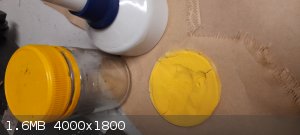werdy666
Harmless

Posts: 9
Registered: 19-1-2021
Location: NSW, Australia
Member Is Offline
Mood: Chilled
|
|
First Bismuth Trioxide
Hi,
This would not have been possible without a user by the name of B(a)P. He gifted me 2.5 litres each of Sulfuric and Nitric Acid. He
would not accept any money for either of them. And he even delivered them to my front door, which isabout 2 hours north of where he lives in Sydney,
Australia. I hope one day I can pay this generous and kind gift to someone else     
Attached is a photo of some Bismuth Trioxide I made using my Nitric Acid and some Sodium Hydroxide. I got the Bismuth metal from ebay and it says
99.99% pure but there is no guarantees on ebay! 
One thing I have noticed is that all the photos online I have found of Bi2O3 is that the powder is a very pale yellow colour. As you can see in my
photo mine is a deep bright yellow. The photo is of it still moist but since it has dried up it is still very yellow. As a reference for anyone who
knows vegemite, the jar in the photo with the yellow lid is a vegemite jar.
Is this yellow normal or is it indicating a contaminant in my Bi2O3?

|
|
|
Infamous_Reddy
Harmless

Posts: 13
Registered: 25-2-2019
Location: Southern India
Member Is Offline
Mood: Variable
|
|
I haven't worked with Bismuth yet, but I don't think that your Bismuth trioxide contains any contaminants. While most of the photos online show that
it is a light shade of yellow, others show that it has a shade of yellow in your picture. Here are the image addresses of a few images I found through
a quick Google search:
https://tinyurl.com/b7vazdnp
https://tinyurl.com/55dj9s28
https://tinyurl.com/37se9cps
Also, Bismuth trioxide can lose its colour as it ages. This is confirmed by this journal which concludes that Bismuth(III) oxide, when exposed to excess NaOH, can form Bismuth subcarbonate which is white, explaining the overall
pale colour of a few samples and this effect is amplified when exposed to light. Again, please correct me if I am wrong.
[Edited on 2-5-2021 by Infamous_Reddy]
|
|
|
Lion850
National Hazard
   
Posts: 514
Registered: 7-10-2019
Location: Australia
Member Is Offline
Mood: Great
|
|
Hi werdy666 it looks lovely. Please post details of your procedure.
|
|
|
woelen
Super Administrator
        
Posts: 7976
Registered: 20-8-2005
Location: Netherlands
Member Is Offline
Mood: interested
|
|
I have a reagent grade commercial sample of Bi2O3. It does not contain carbonate (produces no bubbles when it is added to dilute HNO3), but its color
is very pale yellow.
Maybe your product contains some bismuth(V). I have some sodium bismuthate (NaBiO5) and some bismuth(V) oxide. Both are brown/yellow (like certain
kinds of mustard). Bismuth(V) compounds, however, are not really well-defined. It is not pure NaBiO3 and not pure Bi2O5, but there is quite some
bismith(V) in these compounds.
|
|
|
werdy666
Harmless

Posts: 9
Registered: 19-1-2021
Location: NSW, Australia
Member Is Offline
Mood: Chilled
|
|
My procedure was as follows....
Take my sample of Bismuth and placed into a beaker. Poured my itric acid into the beaker. Got Nitrogen Dioxide straight away. Covered it and put ice
on top to allow it to recondense some of the acid
After the reaction slowed down a little i then turned on the hotplate to help the reaction along.
Once the liquid looked clear( it did still have a tinge of colour about it though), I then turned the heat off and put my mixing bar in and added
Sodium Hydroxide to the mixture slowly, as it did start boiling again due to the hydroxide of course.
Checked the PH of the liquid and when it went Alkali I stopped adding the Sodium Hydroxide. I let it mix for around 20 minutes or so and when it was
cool enough I filtered out the yellow powder. Then I let it dry.
The photo I posted was when it was still moist.
Should of I rinsed it with water after filtering it???
|
|
|
Bedlasky
International Hazard
    
Posts: 1219
Registered: 15-4-2019
Location: Period 5, group 6
Member Is Offline
Mood: Volatile
|
|
Woelen: Bismuthates(V) are formed in solid phase (heating Bi2O3 with Na2O or Na2O2), not in solution (at least from what I know, maybe persulfates can
do that??? But HNO3 is too weak oxidiser for this).
|
|
|